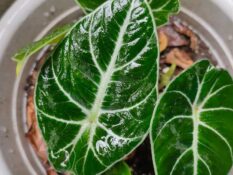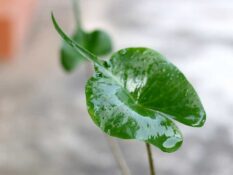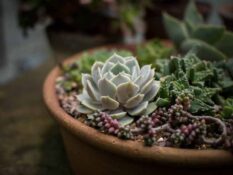Bugleweed (Ajuga reptans) is a low-growing, evergreen perennial used in gardens for centuries. Native to Europe, this plant has spread throughout much of the world and is now found in many temperate climates. It's also quite easy to grow and care for, making it an attractive option for many gardeners.
Characterized by its small blue or purple flower spikes and spreading habit, bugleweed is often used as an edging plant in flower beds or for ground cover beneath trees and shrubs.
This guide will answer most of your questions about how to grow and care for this delightful addition to your garden.
Do bugleweed flower? What color is the bugleweed flower?
Yes, bugleweed plants produce small flower spikes that are typically blue or purple. These flowers grow in early spring and last until mid-summer.
When to plant bugleweed plant?
Bugleweed can be planted in either spring or fall, though the best time to plant is generally in late summer. This will give the plants ample time to establish themselves in their new environment before the cold weather sets in. If you're planting a container-grown plant, this will help ensure the plant has time to acclimate to its new environment before winter arrives.
Types of bugleweed: what are the recommended varieties of bugleweed plants?
There are many varieties of bugleweed plants, each with its unique characteristics. Some popular varieties include:
- Ajuga reptans 'Blueberry Muffin.'
- Ajuga reptans 'Black Scallop"
- Ajuga reptans ‘Burgundy Glow’
- Ajuga reptans ‘Bronze Beauty.’
- Ajuga reptans ‘Chocolate Chip.'
- Ajuga reptans ‘Catlin's Giant.’
Bugleweed soil requirements: What is the best soil for the bugleweed plants?
Bugleweed prefers neutral to slightly acidic soil (pH 6.0-7.0). A sandy loam soil with good drainage is ideal. Adding compost or manure to the soil will also help increase its porosity, promoting healthy root growth and better water drainage.
Adding amendments and enhancers can also help improve soil quality. Adding organic matter such as manure or compost will help increase the nutrient content of the soil and promote better drainage. Adding gypsum to the soil will help reduce the alkalinity of heavy soils, while adding lime can increase the pH level of acidic soils.
Bugleweed light requirements: How much light does the bugleweed plant need?
Bugleweed plants prefer partial to full sun, though they will tolerate light shade. If your area gets a lot of direct sunlight, you should protect the hottest part of the day, such as a shade cloth or an awning.
Plant grow light can also supplement the natural sunlight in shady areas. This will help ensure the plants get adequate light for optimal growth and flowering.
Bugleweed water requirements: How often to water the bugleweed plant?
Bugleweed plants should be watered regularly. The soil must be moist but not soggy and drains well. Do not over-water, as this can lead to root rot and other issues. The best way to determine if your bugleweed needs water is to check the soil moisture around the plant's base.
You can also use a soil moisture meter to check the exact amount of water in the soil. If the meter reading is below the recommended level, it's time to water your bugleweed.
An irrigation system can also provide the plants with a consistent and steady water supply. Drip irrigation systems are particularly effective for bugleweed.
Bugleweed temperature range: What temperature can bugleweed tolerate?
Bugleweed is a hardy plant and can tolerate temperatures as low as -15°F. It should be planted in a sheltered location in colder climates to protect it from the coldest temperatures.
To protect plants during bad weather, use cold frames, greenhouse, and plant protective covers to provide extra protection.
Bugleweed humidity: Do bugleweed like humidity?
Bugleweed plants do not require high levels of humidity levels dry climates. It may be beneficial to provide them with extra humidity by misting them occasionally or placing a humidifier near the plants.
To maintain the humidity of plants around your bugleweed, you can use a humidifier, misters, and vaporizers to increase the humidity levels in your garden.
Bugleweed plant propagation: How to propagate bugleweed plant?
Several methods of propagating plants include propagating plants, including seeds, cuttings, and division.
Propagate bugleweed plant from seed
Bugleweed plants can be propagated from seed. Plant the seeds in pots filled with moist, well-drained potting soil and place them in a sunny location. Keep the soil moist but not soggy, and they should germinate within a few weeks.
Propagating bugleweed plant by cutting
Bugleweed plants can also be propagated by taking stem cuttings. Take a stem cutting about 3-4 inches long and remove the bottom leaves. Place the cutting in a moist potting mix and keep it out of direct sunlight. The cutting should take root within a few weeks.
Propagating bugleweed plant by division
Bugleweed plants can also be propagated by division. Carefully dig up the plant and gently divide it into two or more sections. Place each section in a pot with moist, well-drained soil and water. Keep the soil moist but not soggy; new plants should be established in a few weeks.
Potting bugleweed plant
Bugleweed cuttings or the divisions should be potted in a well-draining potting mix. If you are using commercial potting soil, make sure it is formulated for use with indoor plants. If you are making your own soil mix, include ingredients such as compost, peat moss, and perlite to ensure proper drainage.
It is important to select the correct pot size or container for your bugleweed plant. Too small of a container can inhibit growth, and too large of a pot can cause the soil to become waterlogged and cause root rot. When potting your bugleweed, leave at least an inch or two of space from the pot's rim to the soil.
How to prune bugleweed plant?
Pruning is an important part of bugleweed plant care. It helps to keep the plants looking neat and promotes new growth. Prune your bugleweed in late winter or early spring before the plant bloom. Prune away dead, diseased, or damaged stems and leaves and remove any excess foliage. Pruning will also help keep the plant in a manageable size and shape.
How to fertilize bugleweed plant?
Fertilizing your bugleweed plants is an important part of their care. Use a balanced, slow-release fertilizer formulated for indoor plants and apply it in the spring. Follow the directions on the fertilizer label for application rate and frequency. Fertilizing too often or with excessive fertilizer can damage the roots and cause leaf burn.
Choose a high-quality fertilizer with a balanced NPK (nitrogen, phosphorus, and potassium) ratio for fertilizing your bugleweed. Some of the plants also benefit by adding appropriate soil amendments.
Common bugleweed diseases and how to manage bugleweed disease?
Bugleweed plant is prone to a few common pests and diseases, including:
Aphids: Aphids are small, pear-shaped insects that feed on the sap of plants. They can cause leaf distortion and stunted growth. To control aphids, use an insecticidal soap or horticultural oil.
Powdery mildew: Powdery mildew is a fungal disease that can cause yellow spots on the plant's leaves. To control powdery mildew, use a fungicide or spray with a mixture of one-part milk and nine-part water.
Root rot: Root rot is a fungal disease caused by overwatering or poor drainage. To prevent root rot, ensure the soil is not soggy and water only when the top inch of soil is dry.
In case of an outbreak, Use good quality insecticides and fungicides to control the pests and diseases. Follow the directions on the label for safe, effective use of insecticides and fungicides.
Takeaway on how to grow and care for bugleweed
Bugleweed plants are easy to care for and can be a great addition to any home or garden. They should get enough light and water and fertilize with a balanced NPK ratio fertilizer. Be sure to watch out for common diseases and pests, such as aphids and powdery mildew, and treat them with appropriate insecticides or fungicides. Lastly, it is important to remember that Tillandsia kolbii can be a great choice for those looking for an easy-to-care-for and long-lasting plant to grow indoors or outdoors. Its attractive rosettes and air-purifying properties can greatly add to any home or garden.
Explore our plant growth and care guides collection to add more plants to your garden.
If you're new to gardening or a seasoned pro, join our supportive AgFunnel community of gardeners and share a picture of your garden!
FAQs
What is bugleweed?
Bugleweed is a perennial herbaceous plant belonging to the family Lamiaceae. It is native to Europe, Asia, and North Africa and is characterized by its bright green, small leaves, and flowers ranging from white to pink. Bugleweed can be grown in pots and garden beds and is easy to care for.
Where to put bugleweed?
Bugleweed can be grown both indoors and outdoors, depending on your preferences. It prefers a sunny location with well-drained soil but will tolerate partial shade. When growing indoors, please place the plant in an area with plenty of light and humidity.
How often should bugleweed be watered?
Bugleweed is a drought-tolerant plant and does not need to be watered often. When watering, make sure the soil is damp but not too wet. Allow the soil to dry out slightly between waterings and only water when necessary.
How to get bugleweed to bloom?
To get your bugleweed to bloom, it is important to provide the plant with adequate sunlight, water, and fertilizer. Give it a few hours of direct sunlight each day and avoid overwatering. Additionally, fertilizing with a balanced NPK ratio fertilizer can help promote blooming.
Does bugleweed plant like sun or shade?
Bugleweed is a sun-loving plant and does best when placed in an area with plenty of light. While the plant can tolerate partial shade, it will thrive best in a spot that receives at least six hours of direct sunlight daily.
Is the bugleweed plant annual or perennial?
Bugleweed is a perennial plant, meaning it will come back year after year with proper care. It can be grown indoors and outdoors and does not require special attention or maintenance to flourish.
Does the bugleweed plant come back every year?
Bugleweed is a perennial plant that will come back year after year with proper care. Make sure to give the plant enough light and water and fertilize with a balanced NPK ratio fertilizer to promote blooming. With the right care, it will continue to come back year after year.
Are bugleweed plants toxic to cats?
No, bugleweed plants are not known to be toxic to cats. However, it is always best to keep all houseplants out of reach of your pets to avoid any potential health problems. Additionally, ensure adequate drainage when potting the plant and avoid overwatering to prevent root rot issues.
Are bugleweed plants toxic to dogs?
No, bugleweed plants are not known to be toxic to dogs. However, it is always best to keep all houseplants out of reach of your pets to avoid any potential health problems. Additionally, ensure adequate drainage when potting the plant and avoid overwatering to prevent root rot issues.
Are bugleweed plants toxic to pets?
No, bugleweed plants are not known to be toxic to pets. However, it is always best to keep all houseplants out of reach of your pets to avoid any potential health problems. Additionally, ensure adequate drainage when potting the plant and avoid overwatering to prevent any root rot issues.
How cold can bugleweed plants tolerate?
Bugleweed plants are hardy to USDA zone 3 and can tolerate temperatures down to -33°F. However, they prefer milder temperatures and may struggle to survive prolonged periods of cold or frost. If you live in a colder climate, grow the plant indoors or consider covering it during cold winter days to protect it from potential damage.
How often to water the bugleweed plant?
Bugleweed is a drought-tolerant plant and does not need to be watered often. When watering, make sure the soil is damp but not too wet. Allow the soil to dry out slightly between waterings and only water when necessary. Additionally, ensure adequate drainage when potting the plant and avoid overwatering to prevent any root rot issues.
When to stop watering the bugleweed plant?
It would help if you stopped watering the bugleweed plant once the soil is damp but not too wet. Allow the soil to dry out slightly between waterings and only water when necessary. Additionally, ensure adequate drainage when potting the plant and avoid overwatering to prevent any root rot issues.
When to fertilize bugleweed plant?
Fertilizing the bugleweed plant once a year with a balanced NPK ratio fertilizer can help promote blooming. Applying fertilizer during spring is ideal as it will help boost growth and development. Make sure to read the label on your fertilizer for usage instructions, as different products can vary in strength and application. Additionally, always apply fertilizer to damp soil, as applying it to dry soil can cause burning.
Can the Care Guidelines for Alligator Juniper Plants be Applied to Ajuga Plants as Well?
The care guidelines for growing alligator juniper plants, such as proper watering, well-drained soil, and ample sunlight, can generally be applied to ajuga plants as well. Both plants thrive in similar conditions, and by following similar care instructions, gardeners can help both types of plants flourish in their garden.
Where to buy bugleweed plants?
Bugleweed plants can be purchased at local garden centers, nurseries, and online retailers. Choose a reputable seller offering high-quality plants and detailed care instructions. You can also look for local farmers' markets or plant swaps in your area to get started with your own bugleweed plant.

How to master gardening? Download these essential home and gardening ebooks today!












